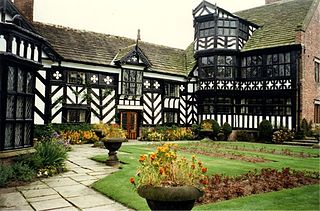Related Research Articles

There have been three baronetcies created for members of the Assheton family, two in the Baronetage of England and one in the Baronetage of the United Kingdom. Two of the creations are extinct while one is extant.

There have been two Baronetcies created for persons with the surname Austen, one in the Baronetage of England and one in the Baronetage of Great Britain. Both creations are extinct.
There have been two baronetcies created for persons with the surname Acton, both in the Baronetage of England. One creation is extant.
There have been nine baronetcies created for persons with the surname Anderson, four in the Baronetage of England, one in the Baronetage of Great Britain and four in the Baronetage of the United Kingdom. All creations are extinct.
Sir William Lowther, 1st Baronet was an English landowner from Swillington, West Yorkshire, and a baronet in the Baronetage of Great Britain.

There have been three baronetcies created for members of the Vernon family.
Four baronetcies have been created in the surname of Fowler, all of which are now extinct.
There have been two Charlton Baronetcies:-
The Baronetcy of Dalston of Dalston was created in the Baronetage of England on 15 February 1641 for William Dalston of Dalston Hall, near Carlisle, Cumbria.

The Fitton Baronetcy, of Gawsworth in the County of Chester, was a title in the Baronetage of England. It was created on 2 October 1617 by James I for Edward Fitton, of Gawsworth Hall, Gawsworth, Cheshire. The Fitton family were settled in Gawsworth from about the 13th century. The first Baronet's ancestors included Sir Edward Fitton (1500–1553), High Sheriff of Cheshire in 1544 and Sir Edward Fitton (1527–1579), Treasurer of Ireland and President of Connaught. His father Sir Edward Fitton (1548–1606) was an unsuccessful colonist of Munster. His sister, Mary Fitton, was Maid of Honour to Elizabeth I.
There have been two baronetcies created in the Baronetage of England for members of the Culpeper family of Kent and Sussex. Both are extinct.
The Halton Baronetcy, of Samford Parva in the County of Essex, was a title in the Baronetage of England. It was created on 10 September 1642 for William Halton. The title became extinct on the death of the sixth Baronet on 9 February 1823 aged 77.
The Myers Baronetcy was a title in the Baronetage of the United Kingdom. It was created on 3 July 1804 for Lieutenant-General William Myers, Commander of the British Forces in the West Indies. The title became extinct in 1811 on the death of the second Baronet, who was killed in action at the Battle of Albuera.
The Doyle Baronetcy, of Guernsey, was created 29 October 1825 in the Baronetage of the United Kingdom for John Doyle. It became extinct in 1834. Boyle had been gazetted a baronet in 1805 but this creation does not appear to have passed the Great Seal.

Sir Robert Barnham, 1st Baronet of Boughton Monchelsea Place was an English politician who sat in the House of Commons from 1660 to 1679.
The Brabazon Baronetcy, of Newpark in the County of Mayo, was a title in the Baronetage of Ireland. It was created on 16 December 1797 for Anthony Brabazon. He was the eldest son and heir of George Brabazon, of New Park in County Mayo, fourth in descent from Sir Anthony Brabazon of Ballinasloe Castle, younger brother of Edward Brabazon, 1st Baron Ardee, ancestor of the Earls of Meath. His son, the second Baronet, represented County Mayo in Parliament. The title became extinct on his death in 1840. Brabazon Park was eventually inherited by Hugh Brabazon Higgins, only son of Luke Higgins of Castlebar by his second wife Catherine, sister of Sir Anthony Brabazon. He was a Captain in the 15th Hussars, and adopted the surname of Brabazon by royal licence of 15 September 1852. He died in 1864, leaving issue.

Sir George Hume, 1st Baronet, of Castle Hume, Fermanagh, was a landowner and baronet of Scottish descent.
Sir Charles Hume, 4th Baronet was a baronet of the Baronetage of Ireland. The baronetage became extinct on his death without an heir.
Sir Nicholas Cole, 1st Baronet was an English Royalist during the English Civil War.

Sir Ralph Cole, 2nd Baronet was an English politician.
References
- A Genealogical and Heraldic History of the Extinct and Dormant Baronetcies of England Ireland and Scotland John and John Bernard Burke 2nd Ed (1844), p. 124
- Leigh Rayment's list of baronets